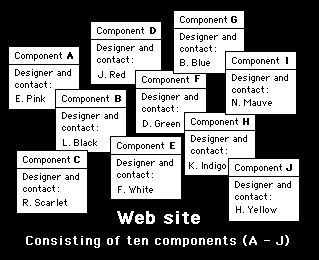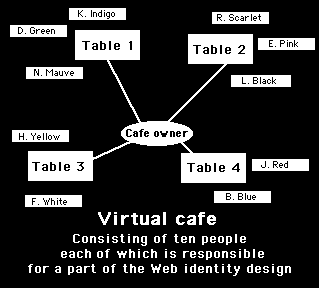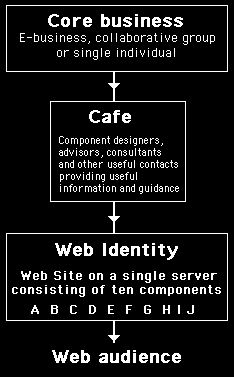
Chapter 6
Exploring the weird
Web presence as a system
A virtual cafe, centred on an individual, can be thought of as a system of interacting components (people) that change and reconfigure as the system (cafe) responds to the needs of that central individual. Such a system cannot be planned, it has to be grown in order for it to adapt and evolve.
In trying to use a similar approach to building a Web site identity, the question becomes, "Where do you start?" The answer has to be "With a green frog". The solution has to emerge without preconceptions and free of any stereotyped ideas.
In the last chapter, the green frog approach got as far as creating a Web name. But, when it came to going on from there – to give the name and address a purpose and functions – there appeared to be a confusion of technology. By asking around, to see how other people are faring in their efforts to create Web identities, the way seemed fraught with pitfalls and knowledge gaps.
It would seem that many owners of Web sites, their advisors and technicians are not really understanding what they were doing. They are following the lead of each other in a blind attempt to get involved in what they conceive as a potentially beneficial business environment. They follow the latest trends and fashion: from novelty to content, from content to eyeballs and click throughs. It is like a treasure hunt where the clues are in the form of the latest buzz words.
Vast sums have been spent on sites that attract mainly other Web site designers who are eagerly searching each other's sites looking for new ideas. The mystery isn't that some people are getting it wrong: it it is that most people were getting it wrong. It seems incredible that so many Web sites are bleeding the core businesses dry while contributing very little, if anything, to the bottom line.
At the time of writing this chapter, an Internet statistics report was published by Pegasus Research International, who had analysed the current burn rate (rate at which companies are spending their capital base) of 339 prominent Internet companies. Out of those 339, eighty percent of them were found to have a negative cash flow and between them they were burning up cash at the rate of nearly two billion dollars every three months. Analysis of the cash flow projections of these companies showed that at least a third of them would probably run out of cash within a year.
The alarming reality is that this was not an analysis of the progress of amateur hopefuls and hastily formed startup companies: it was a report on most of the leading Internet companies of the day. These companies were large and had passed through the traditional avenues of funding where there were safeguards and gateways that were designed to filter out all but the most promising prospects. The inference is that each of these companies must have received their funding after careful screening, after submitting detailed business plans and providing convincing evidence of strong, sound and capable management.
This report then is clear evidence that there is no reliable screening process available. People do not know what elements make up a successful Internet company. All the report shows is that the current method of assessment – a seemingly sound business plan, accompanied by strong management – is not only fallible, but, has a very high chance of failure.
Given this high failure rate, of companies using the conventional and traditional benchmarks for predicting success, we need to find another way: a way that avoids the possibility of cash burn out before reaching viability. This will almost certainly involve using a strategy that spreads risk and would have to include the ability to rapidly change direction at any time and be able to quickly eliminate any parts of the business that are haemorrhaging cash.
In the first book of this trilogy, "The Entrepreneurial Web", it was suggested that the best approach to e-business would be to create a system consisting of many small components that interacted with each other. This approach is modeled upon OOPS (object oriented programming systems) used to design highly complex software programs.
It was further suggested that instead of being concerned with the detailed technology of individual system components, attention should be paid only to their functions and the human designers of the components. In this way, a system could be controlled and engineered through interaction with people rather than the underlying technology. Then, all that any system architect would need to be concerned with would be the observable functioning of the components and the messages that are needed to be sent to them to get them to perform.
This makes sense because it would allow fundamental business considerations to become dominant and prevent decision making becoming clouded over with technological issues. Components could be judged only on the basis of whether or not they functioned efficiently. If they do: fine. If not: out of the door, next case.
Such a strategy, when applied to the design of a Web presence, would see a Web site and all its functions being broken up into many separate components with each component being under the responsibility of a specific, named and identified designer (see figure 6.4).

Figure 6.4
A complex Web site – a Web presence– can be built up a component at a time, with each component being designed by a different designer
Viewed in this way, the design of a Web site, can be seen as a process of communication between people rather than a matter of high technology. This will allow the cafe concept to be used, to arrange the addition of components suitably appropriate for the evolving system. Figure 6.5 illustrates this arrangement with the auteur (the architect of the Web presence for the core business) shown as the cafe owner, dealing with the principal designers of a ten component, Web presence system..

Figure 6.5
A virtual cafe used as the communication framework for the running of a system to provide a Web presence that adapts and evolves
By using the virtual cafe as a conceptual device for organising emails, an auteur, as a system architect, can localise discussions concerning the overall requirements of the Web presence. Individual components and their functions can be discussed with their designers and the auteur can bring designers together when necessary (at virtual table discussions), to discuss interactions and messaging between components.
Such discussions have no need to be very technical. Technical aspects (and more importantly, technical terms and vocabulary) are best confined to the separate worlds of the component designers. The auteur, or architect of a Web presence, will have enough concerns and matters to attend to without needing to learn the technicalities of several totally foreign worlds. All they need is to have their Web presence capable of performing certain functions efficiently. The details, of how this might be done, should be the concern only of the technical designers of the components: not the auteur or architect of the full system.
Note: This idea of an organising level not being concerned with the internal workings of any component at a lower level of the system is one of the principle tenets of object oriented design. Interaction is confined strictly to message passing - which triggers appropriate functional responses to the messages.
System components can easily be added or removed, simply by changing communication links to by-pass or replace them. Similarly, component designers can be included or excluded by including or removing them from the cafe. The cafe can also be used to communicate in all kinds of ways with various advisors, consultants and other useful contacts. These can also be brought in and taken out of the cafe as needs arise or results dictate.
In this way, a Web presence can easily be manipulated and tweaked, so that it adapts and evolves quickly enough to cope with fast changing technology, customer preferences and competitive initiatives. Simply by adding or replacing components, or changing the population of the cafe, an auteur will have full control of the system – ensuring that it performs efficiently to fulfill the fundamental requirements of the core business.
A complete system – a core business, a collaborative group with a common identity or a single individual – interfacing with a Web audience though a Web site, is outlined in figure 6.6.

Figure 6.6
The total system consisting of a core business with an interface to a Web audience. The interface is a Web identity that is made up from components that are organised from within the environment of a virtual cafe